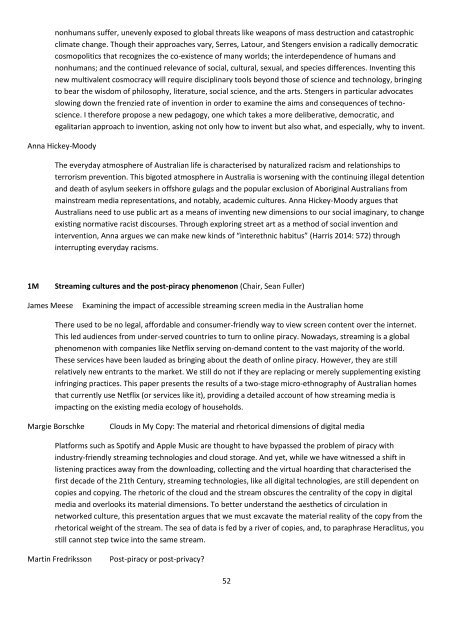Crossroads in Cultural Studies Conference 14-17th December 2016 Program Index
Crossroads-2016-final-draft-program-30-Nov
Crossroads-2016-final-draft-program-30-Nov
Create successful ePaper yourself
Turn your PDF publications into a flip-book with our unique Google optimized e-Paper software.
nonhumans suffer, unevenly exposed to global threats like weapons of mass destruction and catastrophic<br />
climate change. Though their approaches vary, Serres, Latour, and Stengers envision a radically democratic<br />
cosmopolitics that recognizes the co-existence of many worlds; the <strong>in</strong>terdependence of humans and<br />
nonhumans; and the cont<strong>in</strong>ued relevance of social, cultural, sexual, and species differences. Invent<strong>in</strong>g this<br />
new multivalent cosmocracy will require discipl<strong>in</strong>ary tools beyond those of science and technology, br<strong>in</strong>g<strong>in</strong>g<br />
to bear the wisdom of philosophy, literature, social science, and the arts. Stengers <strong>in</strong> particular advocates<br />
slow<strong>in</strong>g down the frenzied rate of <strong>in</strong>vention <strong>in</strong> order to exam<strong>in</strong>e the aims and consequences of technoscience.<br />
I therefore propose a new pedagogy, one which takes a more deliberative, democratic, and<br />
egalitarian approach to <strong>in</strong>vention, ask<strong>in</strong>g not only how to <strong>in</strong>vent but also what, and especially, why to <strong>in</strong>vent.<br />
Anna Hickey-Moody<br />
The everyday atmosphere of Australian life is characterised by naturalized racism and relationships to<br />
terrorism prevention. This bigoted atmosphere <strong>in</strong> Australia is worsen<strong>in</strong>g with the cont<strong>in</strong>u<strong>in</strong>g illegal detention<br />
and death of asylum seekers <strong>in</strong> offshore gulags and the popular exclusion of Aborig<strong>in</strong>al Australians from<br />
ma<strong>in</strong>stream media representations, and notably, academic cultures. Anna Hickey-Moody argues that<br />
Australians need to use public art as a means of <strong>in</strong>vent<strong>in</strong>g new dimensions to our social imag<strong>in</strong>ary, to change<br />
exist<strong>in</strong>g normative racist discourses. Through explor<strong>in</strong>g street art as a method of social <strong>in</strong>vention and<br />
<strong>in</strong>tervention, Anna argues we can make new k<strong>in</strong>ds of “<strong>in</strong>terethnic habitus” (Harris 20<strong>14</strong>: 572) through<br />
<strong>in</strong>terrupt<strong>in</strong>g everyday racisms.<br />
1M<br />
Stream<strong>in</strong>g cultures and the post-piracy phenomenon (Chair, Sean Fuller)<br />
James Meese<br />
Exam<strong>in</strong><strong>in</strong>g the impact of accessible stream<strong>in</strong>g screen media <strong>in</strong> the Australian home<br />
There used to be no legal, affordable and consumer-friendly way to view screen content over the <strong>in</strong>ternet.<br />
This led audiences from under-served countries to turn to onl<strong>in</strong>e piracy. Nowadays, stream<strong>in</strong>g is a global<br />
phenomenon with companies like Netflix serv<strong>in</strong>g on-demand content to the vast majority of the world.<br />
These services have been lauded as br<strong>in</strong>g<strong>in</strong>g about the death of onl<strong>in</strong>e piracy. However, they are still<br />
relatively new entrants to the market. We still do not if they are replac<strong>in</strong>g or merely supplement<strong>in</strong>g exist<strong>in</strong>g<br />
<strong>in</strong>fr<strong>in</strong>g<strong>in</strong>g practices. This paper presents the results of a two-stage micro-ethnography of Australian homes<br />
that currently use Netflix (or services like it), provid<strong>in</strong>g a detailed account of how stream<strong>in</strong>g media is<br />
impact<strong>in</strong>g on the exist<strong>in</strong>g media ecology of households.<br />
Margie Borschke<br />
Clouds <strong>in</strong> My Copy: The material and rhetorical dimensions of digital media<br />
Platforms such as Spotify and Apple Music are thought to have bypassed the problem of piracy with<br />
<strong>in</strong>dustry-friendly stream<strong>in</strong>g technologies and cloud storage. And yet, while we have witnessed a shift <strong>in</strong><br />
listen<strong>in</strong>g practices away from the download<strong>in</strong>g, collect<strong>in</strong>g and the virtual hoard<strong>in</strong>g that characterised the<br />
first decade of the 21th Century, stream<strong>in</strong>g technologies, like all digital technologies, are still dependent on<br />
copies and copy<strong>in</strong>g. The rhetoric of the cloud and the stream obscures the centrality of the copy <strong>in</strong> digital<br />
media and overlooks its material dimensions. To better understand the aesthetics of circulation <strong>in</strong><br />
networked culture, this presentation argues that we must excavate the material reality of the copy from the<br />
rhetorical weight of the stream. The sea of data is fed by a river of copies, and, to paraphrase Heraclitus, you<br />
still cannot step twice <strong>in</strong>to the same stream.<br />
Mart<strong>in</strong> Fredriksson<br />
Post-piracy or post-privacy?<br />
52


